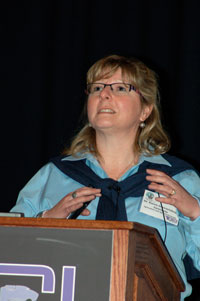Canadian Study Provides
Benchmark Data on Cattle Transport
North American livestock industry needs its own science on which to base guidelines for humane hauling and transport.
MANHATTAN, Kan. (May 20, 2010) — How many hours do cattle spend on a truck when transported? What are the average load densities when animals are transported? How long are they off feed and water? What’s the percentage of downed, injured or dead cattle that result from transportation?

"We have different cattle than Europe and longer distances, so we need to develop our own guidelines [for cattle transport], but we need our own science to make good, solid decisions," Karen Schwartzkopf-Genswein says.
The answers to those questions could help the North American cattle industry establish guidelines for humane animal hauling and transport — but very little data has been collected related to cattle transportation. Thus, Karen Schwartzkopf-Genswein, a research scientist with Agriculture and Agri-Food Canada, has embarked on a large study in Alberta to begin benchmarking some of that information.
Genswein shared her initial research findings during the International Symposium on Beef Cattle Welfare hosted by Kansas State University’s Beef Cattle Institute May 20.
“Transportation is the first and most visible part of our industry,” Genswein said, emphasizing the importance of the topic. “Consumers are exposed to trucks on the highway every day.”
She noted that in Europe strict regulations are in place for the minimum amount of time cattle can be off feed and water during transport and the maximum amount of time they can spend on the truck.
“In Canada and the U.S., transportation regulations are much more broad. We have different cattle than Europe and longer distances, so we need to develop our own guidelines, but we need our own science to make good, solid decisions,” she explained.
Genswein and her colleagues collected more than 10,000 surveys from commercial cattle haulers in Alberta during more than a year’s time. The data collected accounted for 277,440 animals being transported. Among the information collected related to long hauls:
• average distance traveled was 671 miles;
• average temperature was 61° F;
• 23% of all loads used bedding;
• 34% of drivers had more than 10 years of experience;
• for every hour on the truck, shrink increased 0.15 kg; and
• average delay time due to weather, for unloading, border access, etc., was 3.3 hours.
While there is still much information to glean from the study, Genswein said the data provides an initial snapshot of what is presently occurring in the industry related to cattle transportation.
She says fat cattle showed the fewest incidences with handling transport stress, while feeder calves were more susceptible to transport stress.
The information should eventually help establish positive change in the industry. These may include everything from guidelines on the maximum amount of time cattle should be on a truck to the design of trailers for better ventilation.
“I think we can make major changes in the industry,” Genswein said. “The economic losses from cattle transportation are greater than anticipated, so change is needed.”
The beef cattle welfare symposium was conducted on campus at K-State University May 19-21. For additional presentation summaries, return to the Meetings > Other Industry Meetings > News Coverage page of the API Virtual Library. For more about the symposium and an archive to the 2008 symposium, visit www.isbcw.beefcattleinstitute.org.
Editor's Note: This article was written under contract or by staff of Angus Productions Inc. (API), which claims copyright to this article. It may not be published or distributed without the express permission of API. To request reprint permission and guidelines, contact Shauna Rose Hermel, editor, at 816-383-5270.

